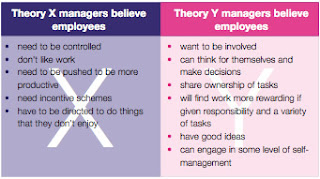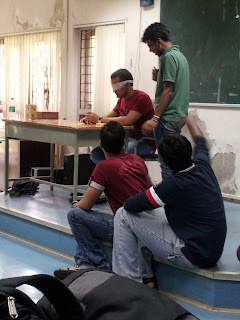This lecture focused mainly on the types of managers and
their behavior based on various situations. Douglas McGregor Managers created
and developed two type of theories for managers.
Theory “X” Managers
These managers think that
employees are lazy and avoid work. They also think employees will work only
under close supervision and control over them. Managerial hierarchy will narrow
down in each level by a single point of control above them. This theory x
managers, not only create counter -productive
environment within the organisation but also create a undesirable situation in
the work place for the employees. This lack of positive thinking in managers
will not produce the final product and lead to the dis-satisfactory performance
of the entire team including manager.
Theory “Y” Managers
In this type, managers believe
that employees are ambitious and self-motivated. They also think that employees
will learn to work with responsibility, self-control, and passion to accomplish
the goal. This creates a friendly work condition in workplace and leads to the
self-satisfaction among the employees. Employees are awarded and recognised for
their performance which results in the achievement of common objective in the
organisation. Here employees growth and trust built among the team will create
good work environment.
Employees are classified into two
categories. Those are lazy employees and good employees. This results in four situations
in a workplace.
Situation one:
Employees and managers are type “X”.
This means employees are lazy and manager thinks that they are lazy. Here they
possibility of motivating the employees to accomplish the task will not be
possible because of the theory x manager. This is a failure of a manager which
will lead to very little scope for growth of an organization
Situation two:
Employees are good but they
manager think that they are lazy. This situation might have happened to many of
the employees in the work place. Lack of communication between employees and
manager will create delay to perform the task. Employees will not be recognized
for their performance and this will demotivate them which ultimately force the
employees to search various other opportunities for a better workplace.
Situation three:
In this
situation, managers are “Y” category but they employees are lazy. Here managers regularly motivate employees to
complete the task and he believes in every one of the employees that they have
hidden potential in them which needs to be identified and motivated. This situation
has high probability of putting the team in right track to achieve the goal. And
it also motivates many less productive employees which ultimately results in
the improvement of workforce in the organisation.
Situation four:
This is
the ideal situation of both employees and managers are hardworking, motivated
and responsible to achieve the common goal set by the organisation. This situation
seldom exists, but journey of an every organisation should be towards this
ideal work environment. Here people will be more productive with job
satisfaction.
These categories
of managers and employees also teach us a lesson in our life …..that is “Be
positive”……..






